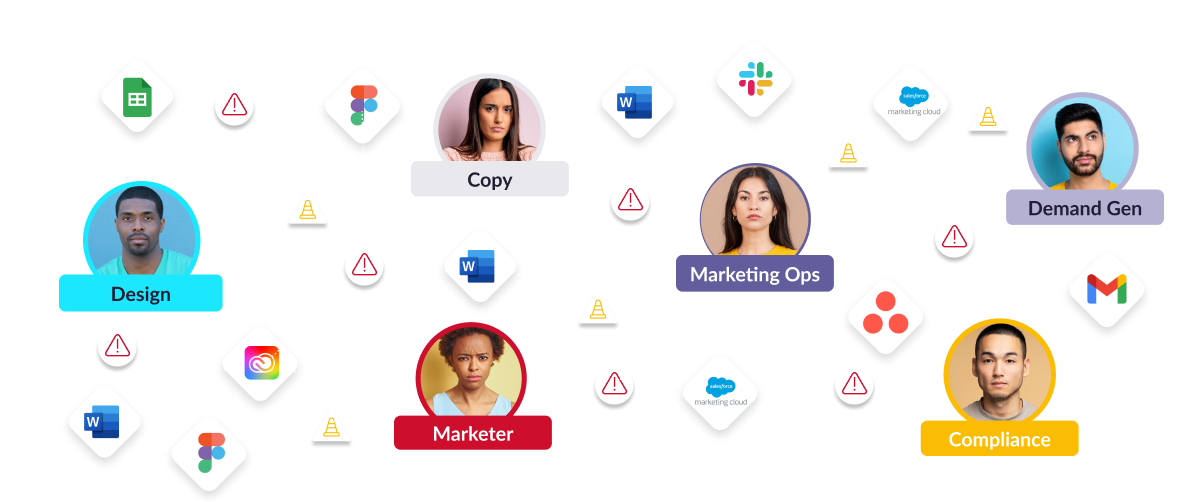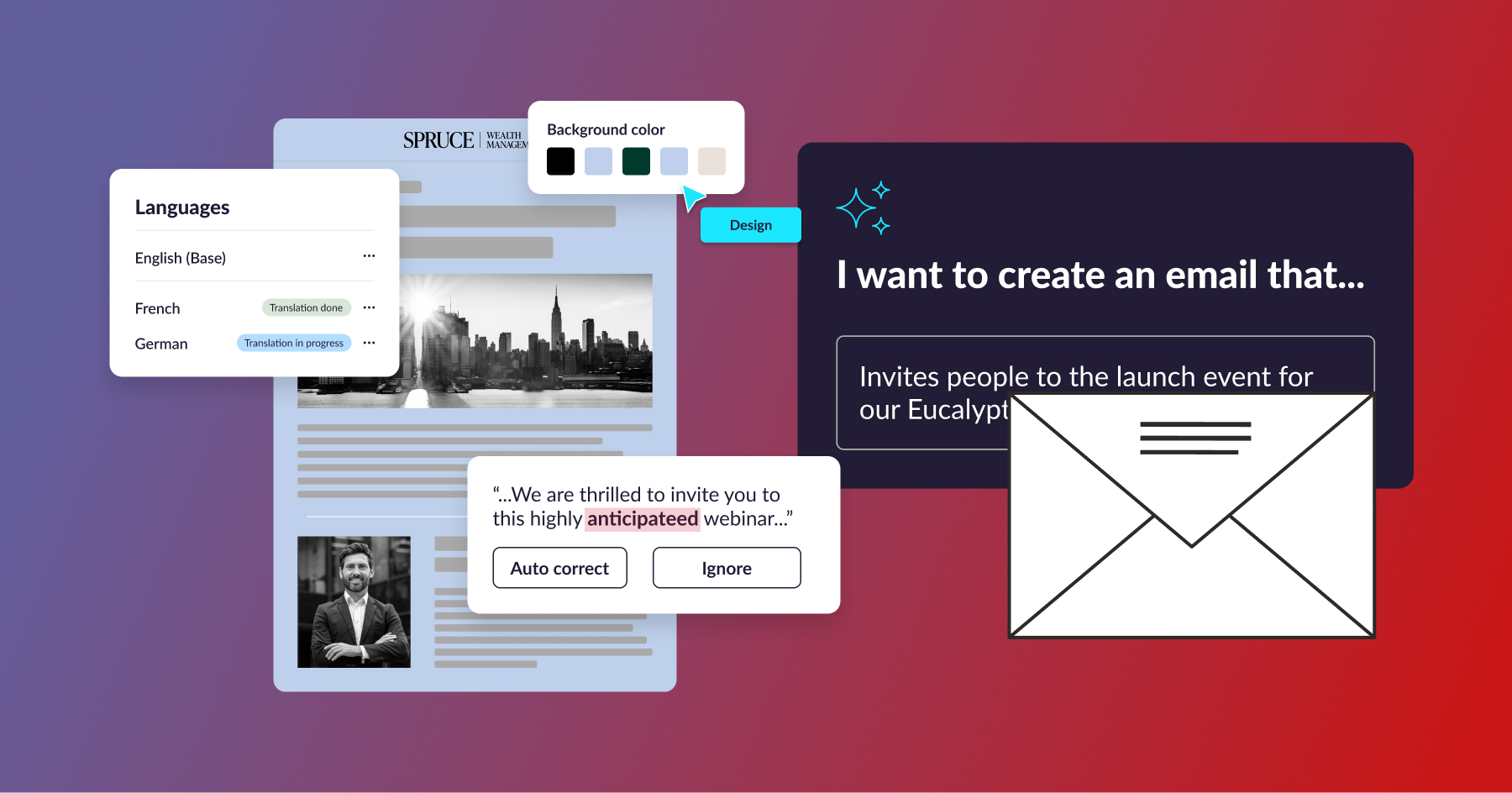Enterprise marketing teams are filled with smart, experienced professionals: demand gen strategists, MarTech pros, designers, compliance experts, and analysts. These teams should be spending their time driving performance and revenue. But instead, many are buried in repetitive production tasks and siloed handoffs.
This is especially true in email and landing page creation, where fragmented workflows and legacy tools result in:
- 2–4 week campaign timelines
- Over-reliance on developers for HTML and QA
- Endless back-and-forth for approvals, edits, and compliance checks
- Missed deadlines and launch windows
Your top talent is stuck playing traffic cop instead of campaign architect building a plan for maximum return.
The big problem: your best talent is misused
Email and landing page production processes are overly dependent on manual tasks, fragmented tools, and siloed handoffs. What should take hours often takes days or even weeks with rounds of redundant review, compliance checks, and brand policing baked into every campaign.
This inefficiency silently erodes ROI. Marketing operations teams are forced to manage complexity instead of optimizing output. And marketing leaders see budgets inflated by process overhead instead of performance growth.
What’s worse? This drain on resources prevents teams from focusing on the very things that drive revenue and offer maximum return: segmentation strategy, creative optimization, testing, and innovation.
Broken Creation Operating Models are stifling your team
While AI tools and automation are evolving rapidly, the processes behind campaign creation haven’t kept up. In fact, most marketing teams still rely on one of three outdated models:
- Design-to-Code: Beautiful but slow; requires dev support and extensive QA
- Brief-to-Template: Faster but rigid; limits creativity and personalization
- Distributed-in-ESP: Fastest but risky; leads to inconsistencies, compliance gaps, and brand erosion

These models may differ in form, but they share a fatal flaw: They’re not built for scale, speed, or strategy in the AI era.
What happens when creation breaks
Without a modern Creation Operating Model, even the most promising marketing plans get bogged down. According to Gartner data, a lack of governance and streamlined production leads to:
- 47% increased costs
- 36% failed AI initiatives
- 29% decrease in revenue
- Negative customer and employee experiences
In short: the cost of inefficiency isn’t just operational, it’s financial and reputational. How you create is just as important as what you create. By modernizing your Creation Operating Model, you can eliminate inefficiency and unleash your team’s full potential.
Make your Creation Operating Model work for you
Most organizations optimize what they create (messaging, targeting, creative) but ignore how it gets done. That’s where the Creation Operating Model comes in.
A modern Creation Operating Model equips your team to:
- Work within governed, automated workflows that eliminate manual errors and bottlenecks
- Enable non-technical users to build compliant, on-brand assets without waiting on creative or dev
- Launch campaigns faster, without compromising compliance or brand integrity
- Reallocate talent from redundant execution to strategic, revenue-impacting initiatives
By treating workflow as a competitive advantage rather than an afterthought, you can turn your creation process into a force multiplier, not a cost center.
Here’s how it works:
- Centralized guardrails ensure compliance, brand alignment, and performance, automatically.
- Non-technical users can build production-ready assets without waiting on dev or design.
- Experts are refocused on strategy, optimization, and personalization aka the real growth drivers.
- Campaign velocity increases by up to 30x, as seen in companies like Cisco.
The SPEED Framework is your roadmap to results
To help marketing and operations leaders identify where their workflows are broken (and how to fix them), Stensul developed the SPEED Framework:
This framework helps teams diagnose inefficiencies while enabling decision makers to model potential returns and justify investments and budget allocations.
Free your talent to do what they do best
When campaign timelines shrink from weeks to days, you don’t just ship faster. You gain the breathing room to focus on what really moves the needle.
- Your marketing operations teams can run performance diagnostics and optimize the content supply chain.
- Your strategists and creatives can A/B test subject lines, analyze journey data, and tune segmentation for higher conversion.
- Your executive team can see measurable gains in productivity and faster pipeline acceleration.
This is how you get maximum return from your most valuable asset: your people.

What this looks like in practice
One global software company used Stensul to replace a dev-heavy production process with a governed, self-service model. The results:
- 90% faster email creation
- 163% increase in qualified leads
- 140% lift in email-sourced revenue
By enabling more team members to create safely and freeing experts to focus on optimization, the company unlocked exponential returns.
Workflows should work for you not against you
Your people are your most valuable asset. But if their time is consumed by bottlenecks, manual reviews, and endless back-and-forth, you’re leaving revenue on the table. So, it’s time to rethink how your team creates.
By modernizing your creation operating model, you don’t just ship faster, you unlock real ROI by shifting your team’s focus back to performance, personalization, and growth.
Ready to get started?
- Run a Free Workflow Audit with a Stensul expert: Schedule here
- Calculate your potential savings: Try the Email Calculator
- Explore real strategies from high-performing teams: Download the SPEED Framework



